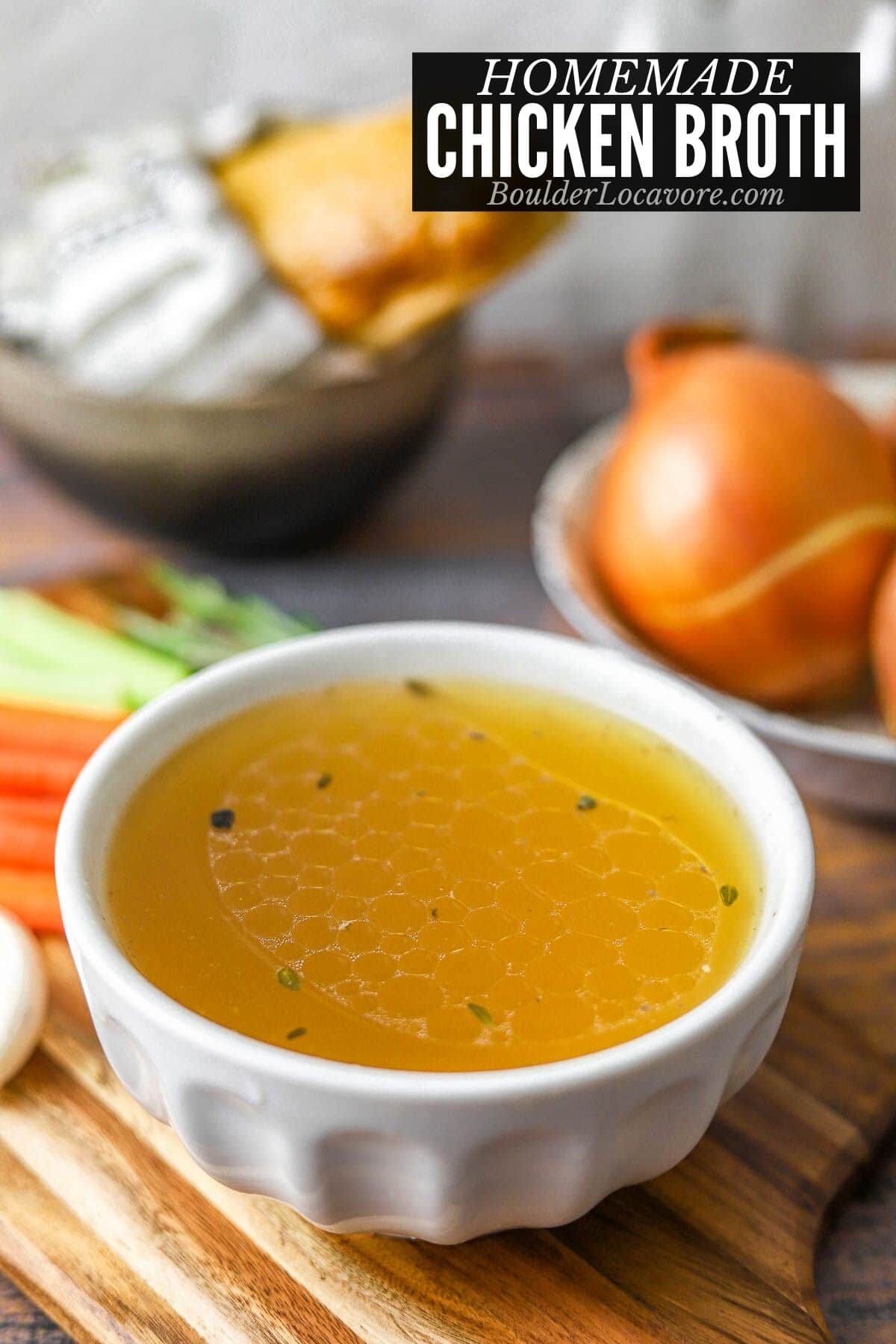Chicken Broth Recipes That Fight Cold and Flu Symptoms Naturally
Wiki Article
The Ultimate Overview to Enjoying and making Organic Bone Broths in your home
Bone brew has gained interest for its many wellness benefits and culinary adaptability. Crafting natural bone broth at home permits people to manage the quality of ingredients, ensuring a nourishing outcome. Understanding the option of bones, important flavoring parts, and correct food preparation strategies is vital. As the process unravels, one might ask yourself exactly how to raise their broth beyond the essentials and integrate it into day-to-day dishes for boosted taste and nourishment.Comprehending the Health Conveniences of Bone Brew
Although bone brew has been a staple in various cuisines for centuries, its wellness advantages have actually gained substantial focus in recent years. Rich in collagen, amino acids, and minerals, bone brew is often touted for its prospective to sustain joint wellness, boost digestive tract feature, and boost skin flexibility. The gelatin originated from cooked bones might assist digestion and aid seal the digestive tract lining, potentially easing problems like leaking digestive tract syndrome.Furthermore, the existence of nutrients such as glucosamine and chondroitin may contribute to decreased inflammation and pain relief in joints. In addition, bone broth is moistening and can function as a nourishing base for stews and soups. Several supporters additionally claim that it increases the body immune system, many thanks to its mineral profile. Overall, the resurgence of rate of interest in bone brew is connected to its regarded capability to promote general well-being and support different bodily functions.Choosing the Right Bones for Maximum Flavor and Nourishment
What elements should one consider when picking bones for brew prep work? The sort of bones made use of substantially affects both flavor and dietary worth. Initially, it is crucial to select bones that consist of a mix of marrow bones, joint bones, and meaty bones. Marrow bones supply healthy and balanced fats and rich tastes, while joint bones add collagen, enhancing the brew's dietary profile.Additionally, sourcing bones from pasture-raised or grass-fed pets guarantees better and even more nutrients, as these animals are typically much healthier. The quality of the bones is additionally vital; selecting bones from local butchers or farmers' markets can assure suitable flavor. Bone dimension matters as well; larger bones launch more jelly, leading to a richer brew. Finally, thinking about the kind of animal-- beef, chicken, or fish-- can influence the last preference, permitting flexible brew choices tailored to specific preferences.Vital Active Ingredients for a Savory Bone Brew

Quality Bone Choice
The structure of a tasty bone brew depends on the careful selection of premium bones. Sourcing organic, pasture-raised or grass-fed bones is vital, as these alternatives are most likely to be without hazardous additives and supply premium nutrients. Varieties such as beef, poultry, or lamb bones each give distinct tastes and health and wellness benefits. Bone types, consisting of marrow bones, knuckle bones, and oxtails, contribute gelatin and collagen, improving the broth's appearance. Selecting bones with a mix of meat and connective tissue can also add splendor and deepness. Furthermore, choosing bones with noticeable marrow ensures a nutrient-dense broth, raising the general high quality. Eventually, spending time in top quality bone selection lays the groundwork for a nourishing and tasty brew.Fragrant Taste Boosters
Choosing premium bones sets the stage for a nutritious and abundant bone brew, however it is the addition of aromatic taste boosters that absolutely elevates the recipe. Active ingredients such as onions, garlic, and carrots not just impart sweetness yet also contribute depth to the broth. Fresh natural herbs like bay, thyme, and parsley leaves include a great smelling note, while flavors such as black peppercorns and cloves introduce heat and intricacy. In addition, including a splash of apple cider vinegar can assist extract minerals from the bones, improving the broth. These flavor boosters produce an unified mix, changing a simple broth into a full-flavored foundation for sauces, stews, or soups, making it a versatile element in any type of culinary collection.Step-by-Step Guide to Making Bone Brew at Home
Developing bone brew in the house can be a satisfying cooking undertaking that enhances both flavor and nourishment in various meals. To start, one have to select high-grade bones, preferably from grass-fed or natural resources. Toasting the bones at 400 ° F for regarding half an hour can increase the taste. Next off, move the baked bones to a huge pot or slow stove and cover them with cold water. Adding a splash of vinegar aids extract minerals from the bones.Include fragrant veggies like onions, carrots, and celery for added deepness, along with herbs and seasonings as desired. Bring the combination to a boil, then minimize to a simmer. It is important to let the broth simmer for a minimum of 12 hours, though longer is more effective for optimum richness. Lastly, strain the brew via a fine-mesh filter and shop it in closed containers, all set to raise meals with its nourishing significance.
Tips for Refining Your Bone Broth Simmer
While simmering bone broth, keeping the best temperature and timing is necessary for achieving a abundant and tasty result. A mild simmer, preferably in between 190 ° F and 210 ° F, assists remove optimum nutrients and tastes without steaming, which can make the broth cloudy. It is advisable to check the pot very closely, changing the heat as needed to preserve this simmer.Timing is likewise crucial; a longer simmer, usually ranging from 12 to two days, permits for deeper taste removal and collagen launch. For hen bones, a 12 to 24-hour simmer suffices, while beef bones gain from longer cooking times.Additionally, skimming off any type of foam or pollutants that increase to the surface area during the first few hours can enhance the broth's quality and preference. Making certain the pot is covered during simmering aids to keep dampness and intensify the tastes, making for a much more enjoyable end product.Imaginative Ways to Make Use Of Bone Broth in Your Cooking
Including important source bone broth right into numerous dishes raises both flavor and dietary value. Cooks and home chefs alike discover that using bone brew as a base for soups and stews enhances depth and richness, changing simple recipes into hearty dishes. It can also be used in risottos, where the brew changes water, permitting the grains to absorb its full-flavored essence.Additionally, bone broth works as a superb food preparation fluid for grains like quinoa or rice, infusing them with nutrients and flavor. For an included spin, it can be utilized in braising meats, leading to tender, savory results. Also sauces gain from a splash of bone broth, enriching their taste profile.Moreover, bone brew can be incorporated right into shakes for an unexpected wellness boost, offering protein and nutrients without compromising taste. These innovative applications display the convenience of bone broth in day-to-day cooking, making it a vital kitchen staple.Storing and Protecting Your Self-made Bone Brew
Proper storage space and conservation of homemade bone broth Source is vital for preserving its flavor and nutritional benefits. Cold strategies and refrigeration ideal practices play an essential function in expanding the broth's rack life. Comprehending these techniques can aid ensure that the broth remains delicious and risk-free for future use.

Freezing Techniques Explained
Freezing methods are important for successfully keeping and maintaining homemade bone brew, guaranteeing its abundant flavors and nutrients stay undamaged for future use. To ice up bone broth, it is advisable to let it great completely before transferring it to storage space containers. Glass containers, silicone molds, or heavy-duty fridge freezer bags are suitable alternatives. When using jars, leave space on top for expansion during freezing. Portioning the brew right into smaller sized amounts permits simple thawing and reduces waste. Tag containers with the day and materials for simple recognition. For peak quality, consume the frozen brew within 3 to 6 months - Beef Broth. Defrosting can be done in the fridge or by utilizing a microwave, making certain that the broth is heated extensively prior to intakeRefrigeration Best Practices
While several concentrate on freezing as a technique of conservation, refrigeration additionally plays a vital function in keeping homemade bone broth efficiently. As soon as cooled down, bone brew need to be transferred to impermeable containers, guaranteeing very little air exposure to avoid perishing. It is advisable to refrigerate broth within two hours of cooking to keep its top quality. Typically, homemade bone broth can be stored in the refrigerator for approximately five days. Identifying containers with days can help track freshness. For peak taste and safety, broth ought to be reheated to a rolling boil before consumption. If longer storage space is needed, cold remains an outstanding alternative, but appropriate refrigeration techniques assure that bone broth stays nutritious and tasty for temporary use.Frequently Asked Inquiries
Can I Utilize Frozen Bones for Making Bone Broth?
The concern of making use of icy bones for bone broth occurs regularly (Bone Broth Delivery). Specialists concur that frozen bones can be made use of efficiently, but they ought to be defrosted prior to cooking to guarantee suitable taste and nutrient extractionHow Much Time Can I Shop Homemade Bone Broth?

Is It Safe to Reheat Bone Brew Multiple Times?
Reheating bone broth numerous times can present security concerns - Organic Bone Broths. Each reheating cycle enhances the threat of microbial growth. It is advisable to reheat only once and keep any type of leftovers quickly to assure safety and high qualityCan I Include Vegetables to the Brew for Taste?
Including vegetables to broth improves flavor and dietary worth. Usual choices consist of carrots, onions, and celery. The vegetables infuse their significance right into the brew, producing a richer and much more tasty last item.What's the most effective Means to Thaw Frozen Bone Brew?
To defrost icy bone broth, one can put it in the refrigerator over night, utilize a microwave on reduced warmth, or submerge the secured container in cozy water, making certain also thawing without compromising flavor or nutrients. It is important to choose bones that include a mix of marrow bones, joint bones, and meaningful bones. Marrow bones give healthy fats visit this page and rich flavors, while joint bones add collagen, enhancing the broth's dietary profile.Additionally, sourcing bones from grass-fed or pasture-raised animals guarantees higher quality and even more nutrients, as these pets are commonly much healthier. Bone types, including marrow bones, knuckle bones, and oxtails, add gelatin and collagen, improving the broth's appearance. Picking high-quality bones establishes the phase for a healthy and abundant bone broth, however it is the addition of aromatic taste enhancers that truly raises the dish. Even sauces profit from a sprinkle of bone brew, enriching their preference profile.Moreover, bone brew can be included into shakes for an unexpected wellness increase, offering healthy protein and nutrients without endangering taste.Report this wiki page